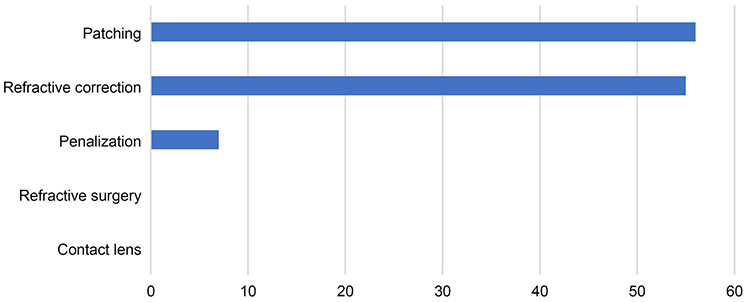J Korean Ophthalmol Soc.
2020 Feb;61(2):190-199. 10.3341/jkos.2020.61.2.190.
Clinical Perceptions and Practice Patterns for Amblyopia in Korea
- Affiliations
-
- 1Department of Ophthalmology, Chung-Ang University Hospital, Chung-Ang University College of Medicine, Seoul, Korea. njmoon@cau.ac.kr
- KMID: 2470742
- DOI: http://doi.org/10.3341/jkos.2020.61.2.190
Abstract
- PURPOSE
We used a questionnaire to explore perceptions and clinical practice patterns of Korean pediatric ophthalmologists in terms of amblyopia.
METHODS
From September to November 2018, we conducted a web-based questionnaire survey of 99 specialists of the Korean Association for Pediatric Ophthalmology and Strabismus who operated ophthalmology clinics in Korea. We received 56 responses (56.57%) and retrospectively analyzed the data.
RESULTS
The average specialist age was 44.0 ± 9.7 years. The mean age of treated amblyopia patients was 3 to 5 years (69.6%); the most common amblyopia was refractive anisometropic amblyopia (75.0%). On average, treatment commenced at 4 years of age (53.6%); child and parent co-operation most significantly influenced treatment success (46.4%). The preferred test was cycloplegic refraction (96.4%) and the preferred treatment occlusion therapy (100%) with glasses correction (98.2%). Occlusion therapy was most commonly performed for 2 hours/day (69.6%); the minimum age for eyeglasses prescription was 2.10 ± 1.18 years. Only three respondents (5.36%) prescribed contact lenses and only one (1.79%) performed refractive surgery.
CONCLUSIONS
In Korea, amblyopia treatment is based on occlusion therapy and glasses correction. However, the time of treatment commencement, the duration of occlusion therapy, and the glasses used for correction varied. It is necessary to develop guidelines for amblyopia treatment; these should reflect current medical conditions.
Keyword
MeSH Terms
Figure
Reference
-
1. Von Noorden GK, Campos EC. Binocular vision and ocular motility. 6th ed. Missouori: CV Mosby;2002. p. 246–297.2. Kim SJ, Park YJ, Yoo JM. The effects of occlusion therapy in patients with anisometropic amblyopia aged 8 years and older. J Korean Ophthalmol Soc. 2010; 51:70–75.
Article3. Scott WE, Stratton VB, Fabre J. Full-time occlusion therapy for amblyopia. Am Orthopt J. 1980; 30:125–130.
Article4. Rho SS, Yang HS, Chang YH, et al. The effect on outcome of amblyopia treatment in children with anisometropic amblyopia. J Korean Ophthalmol Soc. 2007; 48:535–540.5. Choi KW, Koo BS, Lee HY. Preschool vision screening in Korea: results in 2003. J Korean Ophthalmol Soc. 2006; 47:112–120.6. Flom MC, Bedell HE. Identifying amblyopia using associated conditions, acuity and nonacuity features. Am J Optom Physiol Opt. 1985; 62:153–160.
Article7. Kim JB, Moon CS, Chang YH, et al. The amblyopia and strabismus accompanied with anisometropia. J Korean Ophthalmol Soc. 2007; 48:411–417.8. Yeom HY, Han SH, Lee JB. Effects of solitary part-time occlusion for the treatment of monocular amblyopia patients. J Korean Ophthalmol Soc. 2004; 45:1134–1140.9. Hussein MA, Coats DK, Muthialu A, et al. Risk factors for treatment failure of anisometropic amblyopia. J AAPOS. 2004; 8:429–434.
Article10. Ahn JK, Hwang JM. Efficacy of occlusion therapy in amblyopia patients older than 9 years of age. J Korean Ophthalmol Soc. 2002; 43:1724–1729.11. Moon CS, Jin YH. Timing of amblyopia therapy in pure anisometropic amblyopia. J Korean Ophthalmol Soc. 1998; 39:185–192.12. Choi DK, Choi MY. Efficacy of spectacles before amblyopia treatment in anisometropic amblyopia. J Korean Ophthalmol Soc. 2011; 52:550–556.
Article13. Hoyt C. What is next in amblyopia treatment? Ophthalmology. 2015; 122:871–873.
Article14. Tailor V, Bossi M, Greenwood JA, Dahlmann-Noor A. Childhood amblyopia: current management and new trends. Br Med Bull. 2016; 119:75–86.
Article15. Repka MX, Beck RW, Holmes JM, et al. A randomized trial of patching regimens for treatment of moderate amblyopia in children. Arch Ophthalmol. 2003; 121:603–611.
Article16. Holmes JM, Kraker RT, Beck RW, et al. A randomized trial of prescribed patching regimens for treatment of severe amblyopia in children. Ophthalmology. 2003; 110:2075–2087.
Article17. Scheiman MM, Hertle RW, Beck RW, et al. Randomized trial of treatment of amblyopia in children aged 7 to 17 years. Arch Ophthalmol. 2005; 123:437–447.
Article18. Cotter SA, Edwards AR, et al. Pediatric Eye Disease Investigator Group. Treatment of anisometropic amblyopia in children with refractive correction. Ophthalmology. 2006; 113:895–903.
Article19. Holmes JM, Lazar EL, Melia BM, et al. Effect of age on response to amblyopia treatment in children. Arch Ophthalmol. 2011; 129:1451–1457.
Article20. Stewart CE, Moseley MJ, Stephens DA, Fielder AR. Treatment dose-response in amblyopia therapy: the Monitored Occlusion Treatment of Amblyopia Study (MOTAS). Invest Ophthalmol Vis Sci. 2004; 45:3048–3054.
Article21. Kim M, Choi MY. Comparison of results after daily patching and alternate-day patching to treat amblyopia. J Korean Ophthalmol Soc. 2015; 56:254–262.
Article22. Kraus CL, Culican SM. New advances in amblyopia therapy II: refractive therapies. Br J Ophthalmol. 2018; 102:1611–1614.
Article
- Full Text Links
- Actions
-
Cited
- CITED
-
- Close
- Share
- Similar articles
-
- Follow-up Results of the Monocular Amblyopia
- The Relationship between Perceptions of Nursing College Students regarding Clinical Practice Environment and Related Variables
- Clinical Evaluation of Exotropia Combined with Amblyopia in Children
- Clinical Manifestations of Amblyopia in Siblings
- Sensitivity, Specificity and Efficiency of Teller Acuity Cards for Detecting Amblyopia





